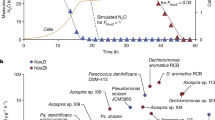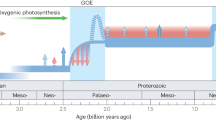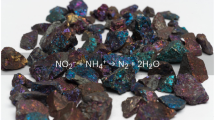Abstract
Traditionally, the description of microorganisms starts with their isolation from an environmental sample. Many environmentally relevant anaerobic microorganisms grow very slowly, and often they rely on syntrophic interactions with other microorganisms. This impedes their isolation and characterization by classic microbiological techniques. We developed and applied an approach for the successive enrichment of syntrophic hydrocarbon-degrading microorganisms from environmental samples. We collected samples from microbial mat-covered hydrothermally heated hydrocarbon-rich sediments of the Guaymas Basin and mixed them with synthetic mineral medium to obtain sediment slurries. Supplementation with defined substrates (i.e., methane or butane), incubation at specific temperatures, and a regular maintenance procedure that included the measurement of metabolic products and stepwise dilutions enabled us to establish highly active, virtually sediment-free enrichment cultures of actively hydrocarbon-degrading communities in a 6-months to several-years' effort. Using methane as sole electron donor shifted the originally highly diverse microbial communities toward defined mixed cultures dominated by syntrophic consortia consisting of anaerobic methane-oxidizing archaea (ANME) and different sulfate-reducing bacteria. Cultivation with butane at 50 °C yielded consortia of archaea belonging to Candidatus Syntrophoarchaeum and Candidatus Desulfofervidus auxilii partner bacteria. This protocol also describes sampling for further molecular characterization of enrichment cultures by fluorescence in situ hybridization (FISH), and transcriptomics and metabolite analyses, which can provide insights into the functioning of hydrocarbon metabolism in archaea and resolve important mechanisms that enable electron transfer to their sulfate-reducing partner bacteria.
This is a preview of subscription content, access via your institution
Access options
Access Nature and 54 other Nature Portfolio journals
Get Nature+, our best-value online-access subscription
$29.99 / 30 days
cancel any time
Subscribe to this journal
Receive 12 print issues and online access
$259.00 per year
only $21.58 per issue
Buy this article
- Purchase on Springer Link
- Instant access to full article PDF
Prices may be subject to local taxes which are calculated during checkout





Similar content being viewed by others
References
Handelsman, J. Metagenomics: application of genomics to uncultured microorganisms. Microbiol. Mol. Biol. Rev. 68, 669–685 (2004).
Edwards, T. & McBride, B. New method for the isolation and identification of methanogenic bacteria. Appl. Microbiol. 29, 540–545 (1975).
Gieg, L.M., Davidova, I.A., Duncan, K.E. & Suflita, J.M. Methanogenesis, sulfate reduction and crude oil biodegradation in hot Alaskan oilfields. Environ. Microbiol. 12, 3074–3086 (2010).
Strous, M., Heijnen, J., Kuenen, J.G. & Jetten, M. The sequencing batch reactor as a powerful tool for the study of slowly growing anaerobic ammonium-oxidizing microorganisms. Appl. Microbiol. Biotechnol. 50, 589–596 (1998).
Wegener, G., Krukenberg, V., Riedel, D., Tegetmeyer, H.E. & Boetius, A. Intercellular wiring enables electron transfer between methanotrophic archaea and bacteria. Nature 526, 587–590 (2015).
Winogradsky, S. Sur les organismes de la nitrification. Comptes Rendus Acad. Sci. 110, 1013–1016 (1890).
Beijerinck, M.W. Anhaufungsversuche mit Ureumbakterien. Centralblatt f. Bakteriologie II 7, 33–61 (1901).
Harder, W., Kuenen, J. & Matin, A. Microbial selection in continuous culture. J. Appl. Micobiol. 43, 1–24 (1977).
Johnsen, A.R., Wick, L.Y. & Harms, H. Principles of microbial PAH-degradation in soil. Environ. Pollut. 133, 71–84 (2005).
Wittebolle, L., Vervaeren, H., Verstraete, W. & Boon, N. Quantifying community dynamics of nitrifiers in functionally stable reactors. Appl. Environ. Microbiol. 74, 286–293 (2008).
Whittenbury, R., Phillips, K. & Wilkinson, J. Enrichment, isolation and some properties of methane-utilizing bacteria. Microbiology 61, 205–218 (1970).
Whiticar, M.J. Carbon and hydrogen isotope systematics of bacterial formation and oxidation of methane. Chem. Geol. 161, 291–314 (1999).
Reeburgh, W.S. & Heggie, D.T. Microbial methane consumption reactions and their effect on methane distributions in freshwater and marine environments. Limnol. Oceanogr. 22, 1–9 (1977).
Welhan, J.A. & Lupton, J.E. Light hydrocarbon gases in Guaymas Basin hydrothermal fluids: thermogenic versus abiogenic origin. AAPG Bull. 71, 215–223 (1987).
Proskurowski, G. et al. Abiogenic hydrocarbon production at lost city hydrothermal field. Science 319, 604–607 (2008).
Boetius, A. & Wenzhofer, F. Seafloor oxygen consumption fuelled by methane from cold seeps. Nat. Geosci. 6, 725–734 (2013).
Rueter, P. et al. Anaerobic oxidation of hydrocarbons in crude oil by new types of sulphate-reducing bacteria. Nature 372, 455–458 (1994).
Boetius, A. et al. A marine microbial consortium apparently mediating anaerobic oxidation of methane. Nature 407, 623–626 (2000).
Laso-Pérez, R. et al. Thermophilic archaea activate butane via alkyl-coenzyme M formation. Nature 539, 396–401 (2016).
Rabus, R., Fukui, M., Wilkes, H. & Widdle, F. Degradative capacities and 16S rRNA-targeted whole-cell hybridization of sulfate-reducing bacteria in an anaerobic enrichment culture utilizing alkylbenzenes from crude oil. Appl. Environ. Microbiol. 62, 3605–3613 (1996).
Zengler, K., Richnow, H.H., Rossello-Mora, R., Michaelis, W. & Widdel, F. Methane formation from long-chain alkanes by anaerobic microorganisms. Nature 401, 266–269 (1999).
Meckenstock, R.U., Annweiler, E., Michaelis, W., Richnow, H.H. & Schink, B. Anaerobic naphthalene degradation by a sulfate-reducing enrichment culture. Appl. Environ. Microbiol. 66, 2743–2747 (2000).
Wang, L.-Y. et al. Characterization of an alkane-degrading methanogenic enrichment culture from production water of an oil reservoir after 274 days of incubation. Int. Biodeterior. Biodegrad. 65, 444–450 (2011).
Schink, B. Degradation of unsaturated hydrocarbons by methanogenic enrichment cultures. FEMS Microbiol. Ecol. 1, 69–77 (1985).
Rios-Hernandez, L.A., Gieg, L.M. & Suflita, J.M. Biodegradation of an alicyclic hydrocarbon by a sulfate-reducing enrichment from a gas condensate-contaminated aquifer. Appl. Environ. Microbiol. 69, 434–443 (2003).
Raghoebarsing, A.A. et al. A microbial consortium couples anaerobic methane oxidation to denitrification. Nature 440, 918–921 (2006).
McGlynn, S.E., Chadwick, G.L., Kempes, C.P. & Orphan, V.J. Single cell activity reveals direct electron transfer in methanotrophic consortia. Nature 526, 531–535 (2015).
Jaekel, U. et al. Anaerobic degradation of propane and butane by sulfate-reducing bacteria enriched from marine hydrocarbon cold seeps. ISME J. 7, 885–895 (2013).
Jaekel, U., Vogt, C., Fischer, A., Richnow, H.-H. & Musat, F. Carbon and hydrogen stable isotope fractionation associated with the anaerobic degradation of propane and butane by marine sulfate-reducing bacteria. Environ. Microbiol. 16, 130–140 (2014).
Kniemeyer, O. et al. Anaerobic oxidation of short-chain hydrocarbons by marine sulphate-reducing bacteria. Nature 449, 898–901 (2007).
Widdel, F. in Handbook of Hydrocarbon and Lipid Microbiology (ed. Timmis, K.N.) 3787–3798 (Springer, 2010).
Musat, F. & Widdel, F. Anaerobic degradation of benzene by a marine sulfate-reducing enrichment culture, and cell hybridization of the dominant phylotype. Environ. Microbiol. 10, 10–19 (2008).
Tan, B. et al. Comparative analysis of metagenomes from three methanogenic hydrocarbon-degrading enrichment cultures with 41 environmental samples. ISME J. 9, 2028–2045 (2015).
Jaekel, U., Zedelius, J., Wilkes, H. & Musat, F. Anaerobic degradation of cyclohexane by sulfate-reducing bacteria from hydrocarbon-contaminated marine sediments. Front. Microbiol. 6, 116 (2015).
Kleindienst, S. et al. Diverse sulfate-reducing bacteria of the Desulfosarcina/Desulfococcus clade are the key alkane degraders at marine seeps. ISME J. 8, 2029–2044 (2014).
Krukenberg, V. et al. Candidatus desulfofervidus auxilii, a hydrogenotrophic sulfate-reducing bacterium of the HotSeep-1 cluster involved in the thermophilic anaerobic oxidation of methane. Environ. Microbiol. 18, 3073–3091 (2016).
Wegener, G., Krukenberg, V., Ruff, S.E., Kellermann, M.Y. & Knittel, K. Metabolic capabilities of microorganisms involved in and associated with the anaerobic oxidation of methane. Front. Microbiol. 7, 46 (2016).
Gieg, L.M., Duncan, K.E. & Suflita, J.M. Bioenergy production via microbial conversion of residual oil to natural gas. Appl. Environ. Microbiol. 74, 3022–3029 (2008).
Holler, T. et al. Substantial 13C/12C and D/H fractionation during anaerobic oxidation of methane by marine consortia enriched in vitro. Environ. Microbiol. Rep. 1, 370–376 (2009).
Meulepas, R.J. et al. Enrichment of anaerobic methanotrophs in sulfate-reducing membrane bioreactors. Biotechnol. Bioeng. 104, 458–470 (2009).
Simoneit, B.R.T., Kawka, O.E. & Brault, M. Origin of gases and condensates in the Guaymas Basin hydrothermal system (Gulf of California). Chem. Geol. 71, 169–182 (1988).
Teske, A. et al. The Guaymas Basin hiking guide to hydrothermal mounds, chimneys, and microbial mats: complex seafloor expressions of subsurface hydrothermal circulation. Front. Microbiol. 7, 75 (2016).
Cruse, A.M. & Seewald, J.S. Low-molecular weight hydrocarbons in vent fluids from the Main Endeavour Field, northern Juan de Fuca Ridge. Geochim. Cosmochim. Acta 74, 6126–6140 (2010).
Riedel, C., Schmidt, M., Botz, R. & Theilen, F. The Grimsey hydrothermal field offshore North Iceland: crustal structure, faulting and related gas venting. Earth Planet. Sci. Lett. 193, 409–421 (2001).
Jaeschke, A. et al. Biosignatures in chimney structures and sediment from the Loki's Castle low-temperature hydrothermal vent field at the Arctic Mid-Ocean Ridge. Extremophiles 18, 545–560 (2014).
Baker, E.T. & German, C.R. On the global distribution of hydrothermal vent fields. in Mid-Ocean Ridges (eds. German, C.R., Lin, J. & Parson, L.M.) 245–266 (Wiley, 2004).
Nauhaus, K., Boetius, A., Krüger, M. & Widdel, F. In vitro demonstration of anaerobic oxidation of methane coupled to sulphate reduction in sediments from a marine gas hydrate area. Environ. Microbiol. 4, 296–305 (2002).
Wegener, G. et al. Biogeochemical processes and microbial diversity of the Gullfaks and Tommeliten methane seeps (Northern North Sea). Biogeosciences 5, 1127–1144 (2008).
Ruff, E.S. et al. Methane seep in shallow-water permeable sediment harbors high diversity of anaerobic methanotrophic communities, Elba, Italy. Front. Microbiol. 7, 374 (2016).
Holler, T. et al. Thermophilic anaerobic oxidation of methane by marine microbial consortia. ISME J. 5, 1946–1956 (2011).
Girguis, P.R., Cozen, A.E. & DeLong, E.F. Growth and population dynamics of anaerobic methane-oxidizing archaea and sulfate-reducing bacteria in a continuous-flow bioreactor. Appl. Environ. Microbiol. 71, 3725–3733 (2005).
Jagersma, G.C. et al. Microbial diversity and community structure of a highly active anaerobic methane-oxidizing sulfate-reducing enrichment. Environ. Microbiol. 11, 3223–3232 (2009).
Aoki, M. et al. A long-term cultivation of an anaerobic methane-oxidizing microbial community from deep-sea methane-seep sediment using a continuous-flow bioreactor. PLoS One 9, e105356 (2014).
Orcutt, B.N. et al. Impact of natural oil and higher hydrocarbons on microbial diversity, distribution, and activity in Gulf of Mexico cold-seep sediments. Deep Sea Res. Part II Top. Stud. Oceanogr. 57, 2008–2021 (2010).
Sikkema, J., De Bont, J. & Poolman, B. Mechanisms of membrane toxicity of hydrocarbons. Microbiol. Rev. 59, 201–222 (1995).
McAuliffe, C. Solubility in water of paraffin, cycloparaffin, olefin, acetylene, cycloolefin, and aromatic hydrocarbons1. J. Phys. Chem. 70, 1267–1275 (1966).
Edwards, E.A. & Grbic´-Galic´, D. Complete mineralization of benzene by aquifer microorganisms under strictly anaerobic conditions. Appl. Environ. Microbiol. 58, 2663–2666 (1992).
Widdel, F. & Bak, F. in The Prokaryotes Vol. 4 (eds. Trüper H.G., Balows A., Dworkin M., Harder W. & Schleifer K.H.) 3352–3378 (Springer, 1992).
Brock, T.D. & Od'ea, K. Amorphous ferrous sulfide as a reducing agent for culture of anaerobes. Appl. Environ. Microbiol. 33, 254–256 (1977).
Nauhaus, K., Albrecht, M., Elvert, M., Boetius, A. & Widdel, F. In vitro cell growth of marine archaeal-bacterial consortia during anaerobic oxidation of methane with sulfate. Environ. Microbiol. 9, 187–196 (2007).
Wegener, G. & Boetius, A. An experimental study on short-term changes in the anaerobic oxidation of methane in response to varying methane and sulfate fluxes. Biogeosciences 6, 867–876 (2009).
Deusner, C., Meyer, V. & Ferdelman, T.G. High-pressure systems for gas-phase free continuous incubation of enriched marine microbial communities performing anaerobic oxidation of methane. Biotechnol. Bioeng. 105, 524–533 (2010).
Zhang, Y., Henriet, J.-P., Bursens, J. & Boon, N. Stimulation of in vitro anaerobic oxidation of methane rate in a continuous high-pressure bioreactor. Bioresour. Technol. 101, 3132–3138 (2010).
Wankel, S.D. et al. Anaerobic methane oxidation in metalliferous hydrothermal sediments: influence on carbon flux and decoupling from sulfate reduction. Environ. Microbiol. 14, 2726–2740 (2012).
Cord-Ruwisch, R. A quick method for the determination of dissolved and precipitated sulfides in cultures of sulfate-reducing bacteria. Microbiol. Methods 4, 33–36 (1985).
Aeckersberg, F., Bak, F. & Widdel, F. Anaerobic oxidation of saturated hydrocarbons to CO2 by a new type of sulfate-reducing bacterium. Arch. Microbiol. 156, 5–14 (1991).
Pawlak, Z. & Pawlak, A.S. Modification of iodometric determination of total and reactive sulfide in environmental samples. Talanta 48, 347–353 (1999).
Grasshoff, K., Kremling, K. & Ehrhardt, M. Methods of Seawater Analysis (Wiley, 2009).
Acknowledgements
We thank F. Widdel for his advice and guidance in regard to cultivation and the development of this protocol. We are indebted to R. Appel, S. Menger and T. Holler for their contributions to the maintenance of the enrichment cultures and their suggestions for further improvement of our protocol. This protocol was tested with samples collected during Guaymas expedition AT15/45 in December 2016, Chief Scientist A. Teske, NSF grant BIO-OCE 1357238. This work was supported by the DFG Excellence Cluster MARUM and a Leibniz Grant to A. Boetius.
Author information
Authors and Affiliations
Contributions
R.L.-P., V.K., F.M. and G.W. contributed equally to the design, validation and optimization of this protocol. R.L.-P., V.K. and G.W. prepared the figures; R.L.-P. and G.W. prepared the supplementary videos. R.L.-P., V.K., F.M. and G.W. cooperatively wrote and edited the manuscript.
Corresponding author
Ethics declarations
Competing interests
The authors declare no competing financial interests.
Supplementary information
Step 1A.
Preparation of anoxic medium in a Widdel flask. (MOV 29836 kb)
Step 1B.
Preparation of anoxic medium in a Duran bottle. (MOV 29422 kb)
Step 8.
Addition of hydrocarbon substrates to culture bottles. (MOV 12646 kb)
Step 17B.
Enrichment culture transfer without an anoxic chamber. (MOV 20183 kb)
Step 23C.
Collection and preservation of material for RNA extraction using RNAlater. (MP4 25460 kb)
Rights and permissions
About this article
Cite this article
Laso-Pérez, R., Krukenberg, V., Musat, F. et al. Establishing anaerobic hydrocarbon-degrading enrichment cultures of microorganisms under strictly anoxic conditions. Nat Protoc 13, 1310–1330 (2018). https://doi.org/10.1038/nprot.2018.030
Published:
Issue Date:
DOI: https://doi.org/10.1038/nprot.2018.030
This article is cited by
-
Candidatus Alkanophaga archaea from Guaymas Basin hydrothermal vent sediment oxidize petroleum alkanes
Nature Microbiology (2023)
-
Diversity, metabolism and cultivation of archaea in mangrove ecosystems
Marine Life Science & Technology (2021)
-
Anaerobic oxidation of ethane by archaea from a marine hydrocarbon seep
Nature (2019)
Comments
By submitting a comment you agree to abide by our Terms and Community Guidelines. If you find something abusive or that does not comply with our terms or guidelines please flag it as inappropriate.



